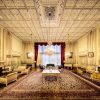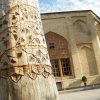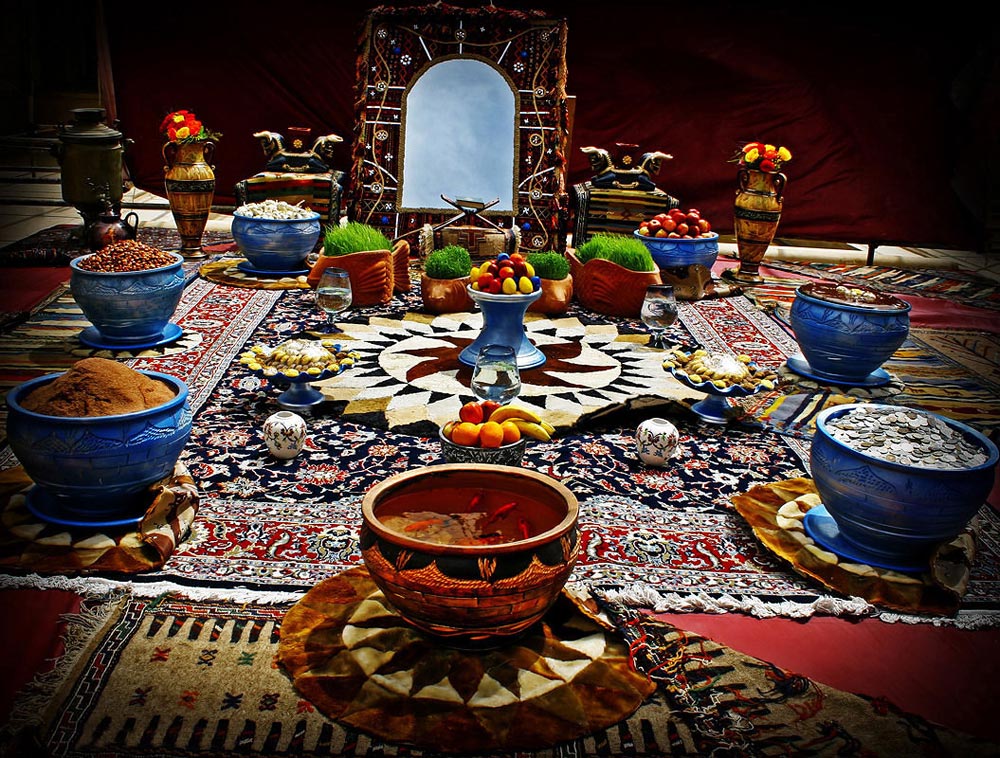The grandest most spectacular masterpiece of the Qajar era, the Golestan Palace (Palace of Flowers), is the oldest historical monument in the city of Tehran. Originally built during the reign of Shah Tahmasp I (circa 1550), it was later renovated during the Qajar period. As Tehran was chosen as the capital of Iran, this lustrous fusion of European and Iranian architecture became the seat of the Qajar government and residence of the imperial family. Fast-forwarding to the Pahlavi era (1925-1979), this royal paradise was only used for formal royal receptions as the Pahlavi dynasty had constructed their own palace in the north of Tehran (Niavaran Palace). Between the years 1925-1945, Reza Shah had some of the buildings at the palace complex destroyed and rebuilt as he felt that the centuries-old architecture of the Qajar was offsetting the modern growth of the city. The Golestan Palace we see today is the result of nearly 400 years of construction and renovation.
Recommended Reads | Internet Access in Iran
The lavish paradise is comprised of 17 palaces, halls and museums:
KAKH-E ABYAZ (Ethnological Museum):
During Nasseredin Shah’s reign in the 18th century, he had a very close and strong relationship with the Ottoman king, Sultan Abdul Hamid. The Ottoman king would send such a plentiful amount of luxurious gifts to the Shah that he decided to construct an exhibit hall worthy of such gifts to honor Sultan Abdul Hamid. These events have caused this hall to become one of the most intriguing ethnological museums of Iran.
2. KHALVAT-E KARIM KHANI (Karim Khan’s Haven):
Previously a part of Karim Khan’s residence, this 17th century ruler’s abode shows some resemblance to Takht-e Marmar. Although it is much smaller and has less ornamentation than Takht-e Marmar, there is a marble throne in the middle of the terrace. Having belonged to a great ruler, Nasseredin Shah was said to have liked this space very much and spent several hours here in private smoking hookah.
MUZ-E MAKHSUS (Special Museum):
Initially, this building was made to house the china and silverware that the Qajar kings had been gifted. The in the Pahlavi period, it was turned into a museum to publically display the rare gifts that had been received by the kings. Today, in addition to the gifts, other rare objects are also being exhibited. Examples of such objects would be the helmet of the Safavid king, Esmail, king Nader’s bow and arrow set, Fath Ali Shah’s armband, Agha Mohammad Khan’s crown, two swords with ivory handles…etc.
HOZ KHANEH (Pool House):
The summer quarters of the imperial family. Here, an intricate cooling system pumped water into the small pools of each designated summer chamber in order to keep it cool and fresh during the hot season. The passing water was eventually channeled outside of the building to irrigate the gardens. Nowadays, this building is also home to the works of famous European painters such as Simon Van Goldbehr and Aivazovsky.
NEGGAR KHANEH (House of Paintings):
This structure was built at the time, in 1872, when Nasseredin Shah (Naser al-Din Shah) had come back from his second tour of Europe. During his trip, he became very impressed by the European’s display and exhibition of their valuable artifacts. Although the original collection of this hall is now dispersed among many different museums in Tehran, it is still host to numerous paintings belonging to the royal court. The pieces pertain to early and late Qajar periods.
AKAS KHANEH (House of Photos):
Nasseredin Shah (Naser al-Din Shah) took a special interest in photography and was a keen photographer himself. This chamber holds some of Nasseredin Shah’s own photos, photos that he had acquired, photos of the Qajar period, as well as vintage cameras and the photography equipment of that period.
CHADOR KHANEH (House of Tents):
Used as a warehouse to store the royal tents. The Qajar lineage was a grand enthusiast of nature and thus, camping trips. Every year, they went on several extravagant camping trips with a sizable entourage that required many servers and attendants to help facilitate the lavish affairs. Considering the numerous people that attended these events, many accommodations were necessary and so, hence the existence of a house of tents.
TALAR-E ADJ (Ivory Hall):
Beautifully decorated by gifts to Nasseredin Shah from European monarchs of the Qajar period, this large hall was used as a royal dining room.
TALAR-E AINEH (Hall of Mirrors):
Although its size is relatively small in comparison to the other halls, this extraordinary glittering marvel is the most distinguished of all of the palace halls. The designer of this extravagent mirror work was Haj Abdoul Hossein Memar Bashi (Sanie-ol-Molk). The beautifully detailed mirror decoration of the interior of this hall is what gives it both its name and its fame.
TALAR-E ALMAS (Hall of Diamonds):
Deriving its name, also, from its extraordinary interior mirror work, the hall of diamonds is devoted to the displaying of 18th century artwork. All of the walls of this hall are covered in European wallpaper and very detailed mirror work.
TALAR-E BERELIAN (Hall of Brilliance):
Just as the former two halls, this hall is also renowned for its intricate mirror work. This hall was built in order to replace a similar previously ruined hall (Talar Bolour/ Crystal Hall). Alongside the brilliant detailed mirror work, it is also famous for its grand chandeliers.
TALAR-E SALAM (Reception Hall):
Used as a reception hall by Nasseredin Shah, travellers and tourists from European courts were received in exquisite luxury, only to be able to compare it to the finest European counterparts. The walls and ceiling are decorated the beautiful fine plaster molding and the floor is detailed with mosaics. During Nasseredin Shah’s reign, it was also used to display Iranian and European paintings.
TALAR-E ZOROOF (Hall of Tableware):
This hall holds all of the chinaware that had been gifted to the Qajar kings by European kings, throughout the ages. Of the rarest and most precious gifts to be showcased in this hall is the chinaware showing the Napoleon wars, the chinaware gifted by King Nicoli I, the gem and jewel covered dishes gifted by Queen Victoria, the chinaware from King Vilhelm and lastly a stunning set made from malachite stone gifted by Alexander III.
EMARAT-E BADGIR (Building of the Windcatcher Towers):
Built in circa 1800, the building of the beautiful and colorful windcatcher towers is a central room which houses the most glamorous stained glass windows in all of Golestan Palace. The purpose of this construction is to provide air flow through the rooms and chambers. Aside from the beautiful stained glass, this building is decorated with two painted spiral columns, a variety of painted marble supports, polychromatic floor tiles with a marvelous colorful floral design (Bott-e Jegheh) alongside painted walls and ceilings covered with detailed mirror work.
SHAMS-OL EMAREH (Edifice of the Sun):
Nasseredin Shah wanted a panoramic view of the city and so began the construction of what took about two years to complete, this 18th century European inspired building. Providing a refreshing panoramic view, the two identical towers of this brilliant building are decorated with many arches and very fine detailed tile work. A true fusion of European and Iranian architecture.
TAKHT-E MARMAR (Marble Throne):
Built in 1806, this imperial terrace represents the finest of Iranian architecture. The royal building is submerged by endless paintings, fine marble carvings, decorative tiles, mirror work, woodcarvings and lattice windows. The actual throne, in the middle of the terrace, is made of 65 pieces of Iran’s famous yellow marble from the Yazd province.
City/Town: Tehran
Street Address: Arg Sq, Bab Homayoun St., Imam Khomeyni Sq.
Telephone: (+98-21) 33113335-8
Website: www.golestanpalace.ir
Operating Days: Every day
Operating Hours: 9am – 5pm
Typical Price: 850.000 Rils. (For all places)
Neighbourhood: Arg mosque – Main Bazaar – Iran Bastan Museum – Post Museum










